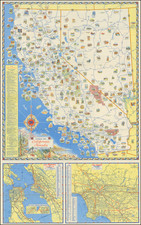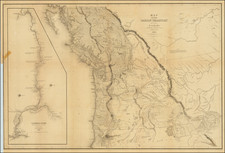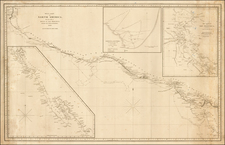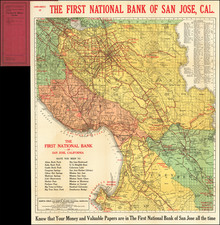Importantly early plan of Pleasanton, California, prepared and printed for pioneer settler John W. Kottinger by Britton & Rey, apparently the first printed map of the city.
Kottinger's plan of Pleasanton is the earliest recorded printed plan of Pleasanton, California, preceded only by the original manuscript plans prepared by Charles Duerr in 1868 and 1869 for Kottinger and his brother-in-law, Joshua Ayres Neal (each of whom married into the Bernal family), who established the town in 1867 and contributed the land for a railway station and warehouses for the railroad, which arrived in 1869.
The first 20 blocks in the city are laid out and plotted, with the street names, including West Street, Downey Street, Cass Street, Haight Street, Main Street, Augustin Street, Juana Street, Angelia Street, Neal Street, Division Street, St. Mary's Street and St. Johns Street. J. Neal's home and J.W. Kottinger home (and perhaps barn) are also located on the map. There appear to be a total of 5 structures already complete, all on Main Street. These are likely the homes of Jacob Teeters, a blacksmith, William Wittner, a carpenter, and Doctor Goucher, who purchased land from Kottinger in 1863.
It is possible that the Kottinger structure shown on the map is Kottinger's barn. John Kottinger's barn was constructed in 1852 and later became Pleasanton's first jail. It is one of the few remaining adobe structures in the area and is the only building in Pleasanton to be designated by the National Register of Historic Buildings. Kottinger became the county's first Justice of the Peace in 1853. Since there were no public buildings at the time, Kottinger used his home for court and his barn for a jail. After criminals were convicted in Kottinger's courts, bandits waiting outside overcame the lawmen and helped the outlaws escape on horseback. Kottinger then had a tunnel built from the courthouse to the jail. Notable desperadoes such as Juaquin Murrietta, Juan Soto, and "Three Fingers" Jack Garcia were tried in Kottinger's court and escorted through the tunnel to jail. Kottinger also opened the first store, planted the first vineyard and built the first hotel in Pleasanton.
Kottinger first surveyed the land which would become part of Pleasanton in 1863 and sold a number of parcels along the future main street. In 1867, Kottinger and Neal learned that the Western Pacific Railroad (purchased by the Central Pacific in 1869) would pass through the future townsite and commssioned a resurvey of the townsite, aligning the streets with the with the incoming railroad line. Kottinger later laid out the town of Pleasanton in a survey conducted in 1867 and memorialized by Charles Duerr in 1868. Thereafter, he began selling lots on the county road, which is now known as Main Street. On September 20, 1869, Mr. Kottinger had a second survey made by Charles Duerr to agree with the line of the railroad. The town immediately sprung to life, and over the next two years the construction of a railroad station assured its success.
The map is of the utmost rarity and is possibly an unique survival. OCLC lists only a photocopy of a similarly titled map at the Bancroft Library, whos entry note reads:
Shows drainage, block and lot numbers, partial land ownership, railroads, etc. Covers area bounded generally by Arroyo del Valle, West St., Augustin St., and East St. Original ms. map in Alameda Co. Recorder's Office, Map Book 5, p. 35. Photocopy reduced from original. Scale [ca. 1:2,700]. Includes county recorder's certification dated Apr. 2, 1917.
It is therefore possible that the copy in the Alameda Country recorder's office is a manuscript map, as there is no reference to Britton & Rey in the Bancroft description. The Bancroft holds a total of 3 photocopies of early maps of Pleasanton (1868-1869), each of which was prepared by Duerr fro either Kottinger or Neal.
The town of Pleasanton was originally named Alisal, but was renamed by John W. Kottinger (1818-1892), an Austrian native, who emigrated to California in 1849 and married Juan Pablo Bernal's daughter, Maria Refugia Bernal (JP Bernal had been one of the 4 original owners of Rancho El Valle de San Jose, the Rancho lands upon which Pleasanton was located). In 1852, Kottinger relocated to the Rancho and built an adobe and frame dwelling on the south bank of the Arroyo Valle, just opposite Bernal's house. In 1867, he was one of the founders of the new town of Pleasonton, which was named after General Alfred Pleasanton, who has served in both the Mexican and Civil War (when the Post Office was established, a clarical error resulted in the changing of Pleasonton to Pleasanton).












![[Southern California Views] Delightful Southern California, The Land of Sunshine and Bloom](https://storage.googleapis.com/raremaps/img/small/74862.jpg)

![Pacific Coast Highways Canada to Mexico [Texaco Tour Maps Routes and Mileages Canada to Mexico]](https://storage.googleapis.com/raremaps/img/small/91594.jpg)